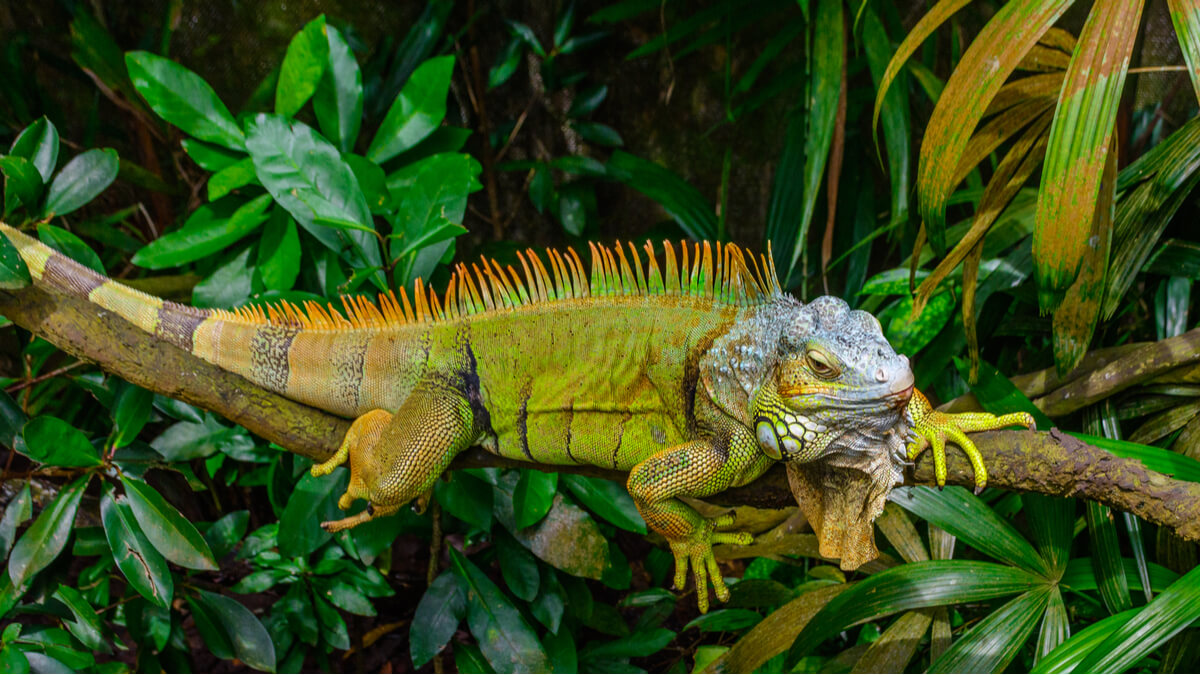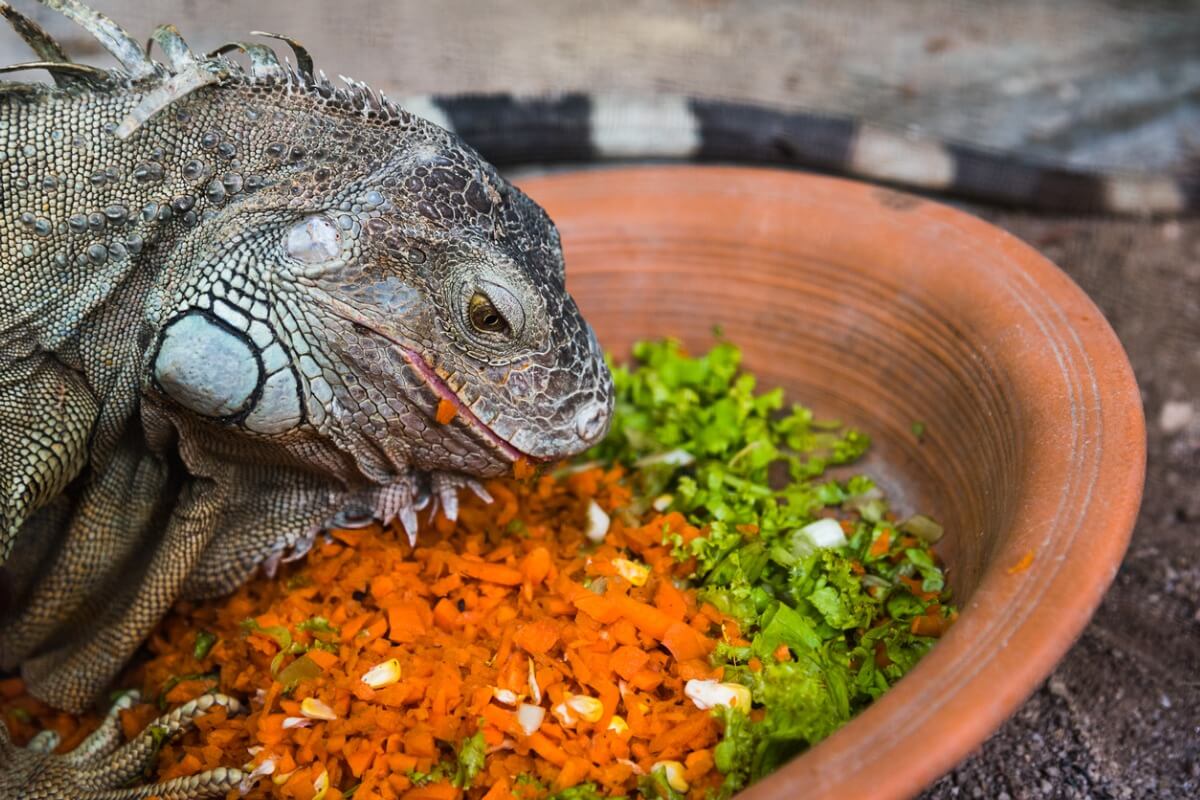My Iguana Doesn't Eat: Why?


Written and verified by the biologist Samuel Sanchez
Iguanas (and all omnivorous reptiles in general) are voracious animals that hardly ever refuse food. In this article, we’ll tell you what you need to do if your iguana won’t eat. And besides, this advice also applies to other exotic pets with an ectothermic temperature regulation method (lizards, geckos, snakes, turtles, amphibians, and others).
Reptiles eat less than mammals and birds, as their metabolic rate is much lower. However, this doesn’t mean that prolonged starvation in any exotic lizard should be considered normal. Behind this situation could be an underlying disease, so don’t ignore it.
Ectotherms feeding
Iguanas of the species Iguana iguana (and all reptiles) are ectothermic animals. This means that their metabolic processes generate very little heat, so they’re unable to regulate their own internal temperature. In other words, they depend on the environment to warm up or cool down.
Predatory reptiles (geckos, varans, Helodermas, and others) eat very little, about 1-2 times a week. This is because they expend little energy during most of the day and the availability of prey isn’t usually constant in the environments they inhabit. In general, carnivorous animals eat less than herbivores.
However, it’s important to remember that the Iguana iguana is a primary herbivore. This means that it feeds almost exclusively on plants, shoots, and fruits, although sometimes it also accepts invertebrates and extra protein from animals. Although it doesn’t eat anywhere near as much as an antelope or a cow, it does eat once or twice a day.
The basis of the diet of the domestic iguana should be vegetables rich in calcium, as the website VCA Hospitals explains. 80-90% of its caloric intake will come from beet greens, mustard greens, turnip greens, alfalfa hay, bok choy, kale, parsley, chard, romaine lettuce, kohlrabi, endive, and dandelion, among others. Fruit should only make up the remaining 10-20%.
Iguanas are herbivores and, therefore, eat much more than a primarily insectivorous reptile.

Why doesn’t my iguana eat?
Although this animal is heavy and voracious, it should be noted that an adult iguana can go 1 or 2 weeks without eating and not suffer too much. Being an ectothermic animal, it’s able to behaviorally slow down its metabolism and reduce the amount of energy it invests in moving, climbing, or leaving the terrarium to interact with the owner.
If your reptile goes one week without eating, don’t worry, but keep an eye out for other clinical signs. If the animal continues without eating, it’s time to consider the following reasons that we’re going to tell you about, and plan a visit to a vet specializing in exotic animals.
Poor terrarium temperature: the main reason an iguana doesn’t eat
The first mistake many first-time keepers make is not lighting or heating the iguana’s terrarium (or the reptile in general) properly. Remember that these animals get their energy from the environment and therefore need a marked thermal gradient to carry out the process known as thermoregulation.
An iguana that doesn’t get enough heat from the environment won’t be able to digest its food properly and will, therefore, be less inclined to eat. Remember the following general rules so that this doesn’t happen to your iguana.
- The daytime temperature of the terrarium should range from 26-29°C (79° – 84° F), but not less. In cold areas, this can be achieved by adding a thermal blanket to the sides or under part of the setup. At night, the temperature range can be lowered to 21-23° C (70° – 73° F).
- The “cold” area of the terrarium where the reptile can rest shouldn’t have a temperature lower than 25.5° C (78° F) during the day.
- The temperature of the hot zone or basking spot should be 35-37° C (95° – 98.6° F). To achieve this, you’ll need to add a UVB lamp on the roof of the terrarium that emits sufficient heat.
If the temperature drops below 20° C (68° F) the animal will surely stop eating, but if it continues to drop it won’t be long before it dies. Checking the thermal parameters of the terrarium is always the first step to answer why your iguana isn’t eating.
Inadequate terrarium and stress
Apart from temperature, the terrarium can be deficient in many other ways. For example, the minimum size of an adult facility should be 1 meter (3.3 feet) long by 2 meters wide and 2 meters high (6.6 feet), as they’re climbers. It should also have rocks and lots of branches so that the reptile can choose the area where it can thermoregulate.
If the terrarium is smaller than required or poorly set up, the reptile will probably stop eating due to stress. It’s necessary to take into account that iguanas become large and heavy, so it isn’t enough to keep them in an area where they can only turn around and little else.
This advice applies to all reptiles. An inadequate terrarium will cause all species to stop eating regardless of their size.
Diseases
Many diseases can affect an iguana and cause it not to eat. Metabolic bone disease due to calcium deficiency, enteric infections, kidney disorders, intestinal parasites, epidermal mites, organ mineralization, and many other conditions are relatively common in these pets.
These conditions often show up with other clinical signs that go beyond inappetence. For example, the expulsion of bloody feces, diarrhea, constant sneezing, epidermal wounds, or swollen eyes may cause it not to eat. It goes without saying that, in these cases, a visit to the vet is a must.
Intestinal impaction
Intestinal impaction is very common in large reptiles such as iguanas. This occurs when the animal ingests non-organic or too heavy materials (such as stones) and these get stuck in some area of the intestine, causing the feces not to excrete. In this case, the iguana stops eating because its digestive tract is clogged.
Disintegrated or inadequate substrates and a low terrarium temperature are usually the main causal agents of impaction. In the early stages, you can try to decongest the animal with warm baths and massages, but, in severe cases, surgical intervention is the only option.
Breeding season
Iguanas begin their breeding season in October-November and this lasts until February. If your specimen is reproductively viable, it’ll probably stop eating and show great interest in leaving the terrarium. If it’s a male, he will also become more aggressive, but this is normal. Many reptiles stop eating when they’re in heat.

Your iguana may stop eating for many reasons, but the thermal imbalance of the terrarium is the main cause in most cases. If you see that these parameters are correct, it’s best to go to the vet as a preventive measure. This is the only way to rule out a pathology before it becomes chronic.
All cited sources were thoroughly reviewed by our team to ensure their quality, reliability, currency, and validity. The bibliography of this article was considered reliable and of academic or scientific accuracy.
- Iguana iguana, ADW. Recogido a 20 de octubre en https://animaldiversity.org/accounts/Iguana_iguana/
- Feeding an iguana, VCA Hospitals. Recogido a 20 de octubre en https://vcahospitals.com/know-your-pet/iguanas-feeding#:~:text=Calcium%2Drich%20vegetables%20that%20are,kohlrabi%2C%20escarole%2C%20and%20dandelion.
- Thermorregulation in reptiles, Reptilerange. Recogido a 20 de octubre en https://www.reptilerange.com/thermoregulation-in-reptiles-how-do-reptiles-keep-warm/#:~:text=Reptiles%20thermoregulate%20using%20the%20heat,can%20retreat%20into%20the%20shade.
This text is provided for informational purposes only and does not replace consultation with a professional. If in doubt, consult your specialist.